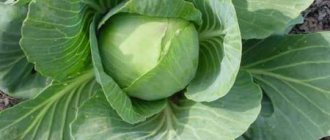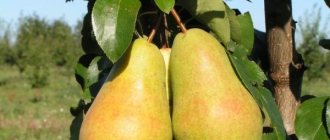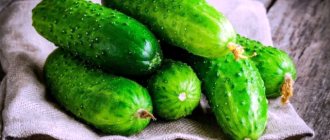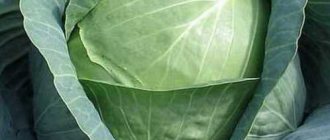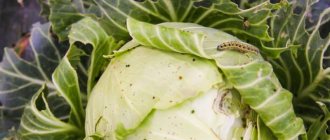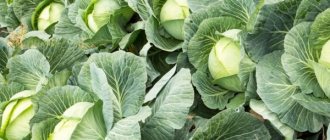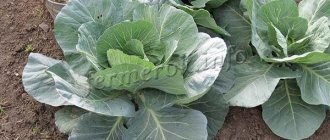Rating of the 15 best varieties of late cabbage for long-term storage for 2021
White cabbage has been grown in Rus' for many centuries. It is used for preparing salads, hot dishes, fermented and salted. And late varieties of cabbage are also intended for long-term storage.
Therefore, vegetable growers do not ignore this vegetable crop - they grow cabbage varieties in their gardens with different ripening periods and purposes.
This article will talk about the best late varieties of cabbage, the features of its cultivation and further care.
, what needs to be done to get a rich harvest of heads of cabbage, stored for long-term storage, and also used for pickling and pickling.
The content of the article:
1. Features of growing and caring for late varieties of cabbage 2. Selecting a site for planting 3. How to properly plant cabbage for seedlings 4. Caring for late cabbage seedlings 5. Planting cabbage seeds in open ground 6. Fertilizing cabbage in open ground 7. 15 best 8 varieties of late cabbage. Reviews of the best varieties of cabbage for storage
Kohlrabi
A cabbage similar to a radish is called kohlrabi. Its homeland is considered to be Ancient Rome, where it was the diet of the poor and slaves. In the 16th century, the vegetable came to Germany, where it was appreciated by the local population. Since then, it has quickly gained popularity in other European countries.
Related article:
Beijing cabbage - growing features
This is a biennial plant. In the first year, it forms a rounded fruit-stem weighing from 200 g to 6 kg (depending on the variety), which is edible. The stem fruits of early varieties develop in 60-80 days, and of late varieties in 130-150. In the second year, flower stalks grow with the further appearance of fruit-pods with seeds.
Kohlrabi loves well-lit areas with light soil of neutral acidity. Due to the rapid ripening of the crop, it can be planted several times a season. It is a cold-resistant crop. Young sprouts can withstand short-term frosts, but with a prolonged drop in temperature they stop developing. Therefore, it is preferable to grow the first crop using seedlings.
Features of growing and caring for late varieties of cabbage
Late-ripening varieties of white cabbage usually ripen in 4.5-6 months, the heads of which do not have a tendency to accumulate nitrates.
Photo of white cabbage
Most of these vegetable plants are intended for growing in open ground. But in order to get a good harvest of heads of cabbage that are not prone to cracking and can be stored in appropriate conditions for up to six months, it is necessary to follow certain rules for growing and caring for the bushes of this vegetable crop.
Video about which hybrids of Dutch selection are best to choose for planting
From this video you can find out what the best hybrids were bred by Dutch breeders. There are only 8 of them here, and all of them are described in detail. Thanks to the author’s experience, you can make the right choice in favor of one or more of them. In his opinion, these are the best representatives in this category.
Perhaps some of them are already familiar, and some you will hear about for the first time. If you know other good hybrids, write about them in the comments. Let people learn about new varieties.
Knowing the characteristics of a particular hybrid will help you make the right choice and get a good harvest on your plot.
I hope that this information will be useful and that the harvest will please you.
Selecting a site for planting
The ideal soil for this vegetable crop will be loam with a neutral or slightly alkaline reaction, to which a sufficient amount of organic fertilizer has been added.
Organic matter (humus, manure or compost) should be added in the fall during digging, and in the spring, complex mineral fertilizers are applied to the beds when planting seeds or cabbage seedlings.
Photo of a plot with cabbage
When growing late cabbage, you should adhere to the rules of crop rotation. Plants from the cruciferous family cannot be planted in one place even for two seasons in a row.
And the best predecessors for white cabbage are:
- cereals;
- legumes;
- carrot;
- tomatoes;
- cucumbers;
- onion.
How to properly plant cabbage seedlings
Late varieties of cabbage are best grown in seedlings, especially in regions with a short warm period, where the heads of cabbage may not have time to ripen before the onset of frost.
When planting cabbage seedlings, it should be taken into account that they are planted in a permanent place when the age of the seedlings is 30-35 days.
Based on this and the climatic conditions of the growing region, the time for planting seed for seedlings is calculated. Since young plants do not have sufficient resistance to cold snaps, they should be planted in the ground when the likelihood of spring frosts is already low. Therefore, you can plant late cabbage seeds for seedlings from March to the end of April.
Planting cabbage seedlings later - video
Purchased seed material undergoes all preparation and disinfection before sale, so it is only soaked before sowing so that the seeds hatch faster.
Seeds collected independently from the garden are processed as follows:
- in hot water – 1/3 hour;
- cold – 1 minute;
- 12 hours – in a solution with microelements;
- 24 hours - in the refrigerator.
To plant seeds, you can use purchased soil for vegetable plants or prepare it yourself at home.
The composition of such soil should be as follows:
- 1 part river sand;
- 1 part garden soil;
- 1 part peat (or humus).
WHITE CABBAGE!
• Krautman white cabbage F1 • Atria cabbage F1 • JUNE cabbage
Such a nutrient substrate must first be disinfected by heating it in the oven at 180 degrees Celsius for 20 minutes or spilled with a weak solution of potassium permanganate.
It is better to plant late cabbage seeds in separate containers so as not to injure young seedlings during the picking procedure.
If this is not possible, then seed material should be planted in large containers at a distance of 2 cm from each other.
Photo of cabbage seedlings
Caring for late cabbage seedlings
After sowing, the soil is moistened, the containers are covered with polyethylene and placed in a warm place so that seedlings appear faster. After most of the seeds have sprouted, the polyethylene is removed and the containers are placed on the windowsills. The air temperature is reduced to 12-14 degrees Celsius.
Daylight hours for seedlings are about 12 hours a day.
Feeding cabbage seedlings - video
Caring for seedlings includes regular watering as the top layer of soil dries, and fertilizing (at least 2 times during seedling growth). 10-12 days before transplanting young plants to a permanent place, they should be hardened. Seedlings are planted in open ground when they have at least 4-5 permanent leaves.
GOOD TO KNOW!
• Rules for growing strong cabbage seedlings
Broccoli
Broccoli is a green cabbage that grows in clusters. A close relative of cauliflower. The Apennine Peninsula is considered the birthplace of the culture, so its name is of Italian origin: “broccoli” translated from Italian means “flowering stems”.
The head of broccoli forms multiple green buds, which are located on thick peduncles and are very close to each other. At technical maturity, the “head” becomes richly green and reaches a diameter of 10-18 cm. The fruit is considered edible before the buds bloom and turn yellow. Moreover, when it is cut from the stem, new “heads” may begin to form from the lateral buds. Therefore, the crop is valued not only for its nutritional qualities, but also for its prolonged fruiting.
Related article:
Agricultural technology for growing kohlrabi cabbage
Broccoli can be grown in open or protected ground. Most often, cultivation is carried out using seedlings. Seeds are sown in early March, and seedlings are transplanted for permanent residence in mid-May. If the growing area is characterized by recurrent night frosts, then young shoots must be insulated. They may not tolerate a temperature drop to -2 C. The optimal temperature regime for normal development of broccoli should be within +17...+23 C. In this case, it is necessary to provide moderate watering at least once a week.
Read more about growing broccoli in the article
Feeding cabbage in open ground
Fertilizers are applied first when preparing beds or in the fall when digging (approximately 80% of the total number of fertilizers applied during the season), as well as during the summer in the form of fertilizing.
Late cabbage needs to be fed at least 3 times per season:
- the first feeding is carried out 12-14 days after seedlings are planted or when grown in open ground after the formation of 4-5 true leaves;
- after the formation of a rosette;
- at the first stage of head formation.
Caring for cabbage in open ground - video
The following preparations are suitable as effective fertilizers:
- Rexolin ABS (if organic fertilizers have not been applied to the soil before;
- Terraflex;
- Terraflex Final.
These funds can be applied at different stages of growing a given vegetable crop.
Further care consists of timely watering, loosening the soil, removing weeds, raking the cabbage 20 days after planting in open ground and another 14 days after the first hilling.
The best varieties of late cabbage
Cabbage for winter storage is in demand by vegetable growers, so breeders have developed a large number of new varieties of this vegetable crop. Sometimes it is difficult for summer residents to make their choice among the variety of varieties of late culture. Below we will talk about the best and most popular varieties of late cabbage grown in Russia.
Aggressor F1
Brought out by breeders from the Netherlands. It is included in the State Register of Russia and recommended for cultivation in the central regions of the country; it bears fruit well in the Urals and Siberia. It takes up to 5 months from the moment sprouts appear to harvest.
The weight of round heads of cabbage is up to 3 kg. Aggressor cabbage is suitable for storage and pickling. The yield of the hybrid does not depend on weather conditions.
Amager 611
Cabbage, bred by Soviet breeders during the 2nd World War. The variety Amager 611 is included in the State Register of the USSR and is recommended for cultivation throughout the country. The ripening of heads of cabbage depends directly on weather conditions - from planting to harvest it can take from 4 to 5 months.
The weight of slightly flattened heads of cabbage is up to 3.5 kg. The harvested Amager 611 cabbage is best used for pickling and pickling. The foliage of freshly picked heads of cabbage is slightly rough, but their taste improves during storage.
Snow White
Late cabbage Snow White was bred by Soviet breeders and is still popular among summer residents from different regions of Russia. From the moment the sprouts appear until the harvest, 4-5 months pass.
Does not tolerate acidified soil, is highly resistant to fusarium and mucous bacteriosis. The weight of ripe, juicy, dense heads of cabbage ranges from 2.5 to 4 kg. Their shape is round or slightly flattened. The harvest ripens smoothly, and the heads of cabbage are not prone to cracking in any weather. Most often, the fruits of the Snow White variety are used for fermentation and pickling.
Valentina F1
This hybrid is relatively new, bred by Russian specialists, and is very popular among Russian vegetable growers. It takes 5.5-6 months from the emergence of seedlings to harvest. The hybrid is characterized by increased resistance to fusarium. There are few non-commercial products - no more than 10%. The shelf life of the crop is more than 7 months.
The shape of ripe heads of cabbage is ovoid, dense, medium in size, with a small stalk, light green in color and weighing 3.3-3.7 kg. Taste – sugary, crunchy, late variety of cabbage Valentina F1 is perfect for fermentation.
Wintering 1474
This variety was bred by Soviet breeders specifically for long-term storage. The Zimovka 1474 variety is included in the State Register of the country and is recommended for cultivation throughout the Volga region, as well as in all regions of the Far East. Even if the storage conditions for the crop are far from ideal, the harvested heads of cabbage will definitely last until mid-January.
With proper storage, by mid-winter, heads of Zimovka 1474 cabbage become more juicy and tasty, ideally they last almost until summer. The weight of the heads of cabbage is 2.2-3.5 kg. Their shape is round, slightly flattened, the stalk is elongated. The fruits are not prone to cracking and are not subject to necrosis during storage.
Kolobok
A variety of Russian selection, bred at the end of the last century, included in the State Register of the country, recommended for cultivation in almost all Russian regions. From the moment the sprouts of the late Kolobok cabbage variety appear until harvest, it takes about 5 months. The round, pale green heads of cabbage are quite dense and weigh up to 5 kg. The harvest is not prone to cracking and has excellent taste.
Shelf life - until the end of spring. Kolobok bushes are resistant to fusarium and are not affected by vascular and mucous bacteriosis or various types of rot. After cutting, the heads of cabbage have a bitter taste, which disappears during storage.
Langedijker
One of the rather old varieties bred by Dutch breeders, but still popular among farmers from around the world. From the moment the sprouts appear until harvest, 5-5.5 months pass.
The main advantages of the late-ripening Langedijker variety: resistance to major diseases that affect other cruciferous plants, long shelf life, improved taste during storage, and the harvested crop tolerates transportation well. The collected heads of cabbage are used fresh, for pickling and pickling.
Lennox F1
This hybrid was bred by Dutch breeders. Included in the State Register of Russia and recommended for cultivation in most Russian regions. From the moment the sprouts appear until harvest, up to 5.5 months pass. The shelf life of heads of cabbage is high, up to 7-8 months. The root system of plants is powerful and well branched, so the late cabbage hybrid Lennox F1 tolerates dry periods well.
The heads of cabbage are spherical, dense, weighing about 2.0-2.2 kg. Up to 10 kg of products are collected from one square. The fruits contain large amounts of ascorbic acid.
Mom F1
This hybrid is recommended to be grown throughout the Volga region. The heads of cabbage are not particularly dense, but can be stored in appropriate conditions for about 6 months. From the moment of emergence of seedlings to harvesting, 5-5.5 months pass.
Heads of Mama F1 cabbage are round, slightly flattened, pale green in color, weighing about 2.6 kg.
Mara
Created by Belarusian breeders. Harvesting is carried out 5.5-6 months after the sprouts appear.
The weight of dense heads of cabbage is up to 4.5 kg; up to 10 kg are collected from one square. The harvested late cabbage variety Mara is ideal for pickling.
Megaton F1
One of the most popular cabbage hybrids among Russian summer residents is a Dutch selection. Ripening time is about 4.5 months. The heads of cabbage are pale emerald in color, dense with a small stalk and weighing 3.3-4.0 kg.
The yield of Megaton F1 cabbage is stable, not dependent on the vagaries of the weather.
Moscow late
This variety has a couple of varieties: Moscow late-15, Moscow late-9. They were bred about half a century ago, variety 15 is distinguished by a high stem, making it easier to care for the plantings, and Moscow late 9 is not affected by clubroot. Moscow late refers to large varieties of late cabbage.
The varieties are recommended for cultivation in the Far East, North-Western and Central regions. The Moscow Late harvest can be stored until the end of June - beginning of July. Plants in open ground can easily withstand cold temperatures down to -10 degrees Celsius.
Orion F1
The Orion F1 variety is included in the State Register of Russia and is recommended for cultivation in the North Caucasus. The harvest of this late cabbage variety ripens within 5.5 months.
The heads of cabbage are elongated, tight and dense, weighing about 2.2 kg. When cut, the color of the leaves is light cream. The taste is pleasant, shelf life is 7-8 months.
Sugarloaf
The variety is included in the State Register of Russia, Sugarloaf cabbage is recommended by experts for cultivation in the west of Siberia, the collected heads of cabbage are for universal use. About 5.5 months pass from the emergence of seedlings to harvest. Can be stored under appropriate conditions for up to 8 months or more.
The shape of the heads of cabbage is spherical, pale green in color, the density is low, the stalk is small. Average weight – 2.3-2.7 kg. The main advantages of the late variety are the complete absence of bitterness in ripe heads of cabbage, high resistance to clubroot, fusarium, and bacteriosis.
Turkiz
The Turkiz variety was bred by specialists from Germany and belongs to the late category. The heads of cabbage are harvested approximately six months after the sprouts appear. The fruits are not prone to cracking, are highly resistant to fungal diseases, and the crop has a shelf life of more than six months. Turkiz cabbage is drought resistant. The shape of the dense, medium-sized heads of cabbage is round, dark emerald in color, and weighs 2.5-3 kg.
Up to 10 kg of tasty juicy heads of cabbage are harvested from one square. The late ripening harvest of this variety of cabbage is most suitable for pickling.
Kharkov winter
This cabbage was bred by Kharkov breeders and entered into the USSR State Register in 1976. Ripening time is about 6 months. The purpose is universal; when stored, the heads of cabbage can last up to 7-8 months.
Ripe heads of cabbage have a round, slightly flattened shape, a rich green color, and a weight of about 4 kg. The heads of this white cabbage do not need to be cut off even with the onset of frost - they do not crack or spoil.
Savoy
Like white cabbage, Savoy cabbage forms a round head of leaves adjacent to each other. However, in Savoy the leaves are not tightly connected and have a corrugated structure. Therefore, the head of cabbage turns out loose. In terms of taste and nutritional qualities, Savoy deservedly occupies a leading position. Its greens are tender and sweet, and the ascorbigen it contains can slow down the growth of cancer cells. However, in Russia this culture is not very popular due to several reasons:
- long growing season (early varieties ripen in 100-120 days, and later varieties - more than 150);
- the plant is more suitable for fresh consumption when preparing salads (soups and main courses are prepared from it, but during heat treatment most of the nutrients are lost);
- poor yield (compared to white cabbage);
- constant maintenance of certain conditions for long-term storage of the crop (temperature, humidity, treating the room with antiseptics, preliminary preparation of fruits for storage, etc.).
Related article:
Agricultural technology for growing kohlrabi cabbage
The best varieties of late cabbage for storage - reviews
Among the variety of reviews about late varieties of cabbage, I would like to highlight some in which vegetable growers talk about growing certain varieties in specific Russian regions.
Tatyana, 40 years old, Chelyabinsk region:
“We grow cabbage every season, including late varieties, which we store for long-term storage. Among these varieties, I would like to highlight the Orion f1 hybrid, which is zoned, in particular, for cultivation in the harsh conditions of the Urals. We grow this cabbage in seedlings, and plant strong seedlings in open ground no earlier than the end of May. The Orion variety is productive, the heads of cabbage are stored almost until the next season.”
Natalya, 50 years old, Smolensk region:
“In my garden I always have room for late cabbage, since we always put it in storage. I have planted many late varieties of cabbage, in particular, Zimovka 1474, Amager 611. Recently, I have preferred to plant the late hybrid Krumont f1, which ripens approximately 5.5 months after germination. The heads of cabbage are quite dense, not prone to cracking, weighing about 2 kg. They can be stored in the cellar for up to 6-7 months.”
Elena, 39 years old, Moscow region:
“In my garden beds, I prefer to plant late Moscow cabbage varieties from late varieties; this variety is specially created for growing in the Moscow region. The heads of cabbage are large, dense, juicy, the mass of heads of cabbage is large - some grow more than 12 kg, and are stored until next summer.”
Preparing cabbage for the winter!
• How to ferment cabbage: home recipes
Svetlana, 46 years old, Barnaul region:
“I grow different varieties of cabbage in my garden, but I always find a place for late hybrids. It’s good that recently a lot of cabbage has appeared, which ripens late and is suitable for long-term storage and for pickling. I grew different late varieties and settled on two – Koloboka f1 and Valentina f1. Both hybrids ripen at approximately the same time - approximately 5 months after emergence, I collect ripe heads of cabbage. They are suitable for fermentation and pickling, and do not lose their taste even after long-term storage for 7-8 months.”
Specialized stores offer a large selection of seeds of late cabbage varieties intended for cultivation in certain regions of Russia
, or throughout the country. This article describes only some of them - with the best characteristics. And what varieties of late cabbage to grow in open ground in your garden is up to the gardeners to decide.


